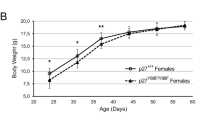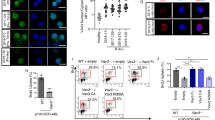Abstract
In order to test if the carboxyl terminal polypeptide of the Retinoblastoma (Rb) tumor suppressor protein, could be used to suppress the growth factor-independent growth phenotype of p210bcr-abl positive myeloid cells, we introduced a truncated form of the 3′ end of the Rb cDNA encoding its last 173 amino acid residues (Rb C-box) which localize into the cytoplasm where the p210bcr-abl transforming protein is found, into myeloid cells (32D) which depends on the p210bcr-abl protein for IL3 growth factor-independent growth (32D-p210). The expression of the plasmid vectors carrying the Rb C-box cDNAs was shown to inhibit the abl tyrosine specific protein kinase activity of the p210bcr-abl oncoprotein and to suppress the IL3-independent growth phenotype of the 32D-p210 cells. The Rb C-box polypeptides did not suppress the growth of the untransfected 32D parental cell line in methylcellulose in the presence of IL3-conditioned medium. These results suggest that the cytoplasmic localization of the p210bcr-abl allows it to escape the effect of intranuclear proteins such as Rb which negatively regulate the p145c-abl kinase.
This is a preview of subscription content, access via your institution
Access options
Subscribe to this journal
Receive 50 print issues and online access
$259.00 per year
only $5.18 per issue
Buy this article
- Purchase on Springer Link
- Instant access to full article PDF
Prices may be subject to local taxes which are calculated during checkout







Similar content being viewed by others
References
Ben-Neriah Y, Daley GO, Mes-Masson AM, Witte ON and Baltimore D. . 1986 Science 233: 212–214.
Daley GQ, Van Etten RA and Baltimore D. . 1993 Science 247: 824–830.
Gale RP and Canaani E. . 1984 Proc. Natl. Acad. Sci. USA 81: 5648–5652.
Goga A, McLaughlin J, Pendergast AM, Parmar K, Muller A, Rosenberg N and Witte ON. . 1993 Mol. Cell. Biol. 13: 4967–4975.
Gossen M and Bujard H. . 1992 Proc. Natl. Acad. Sci. USA 89: 5547–5551.
Heisterkamp N, Stam K, Groffin J, De Klein A and Grosveld G. . 1985 Nature 315: 758–761.
Henderson YC, Guo XYD, Greenberger J and Deisseroth AB. . 1997 Clin. Cancer Res. 3: 145–149.
Jain SK, Langdon WY and Varticovski L. . 1997 Oncogene 14: 2217–2228.
Kharbanda S, Ren R, Pandey P, Shafman TD, Feller SM, Weichselbaum RR and Kufe DW. . 1995 Nature 376: 785–788.
Kipreos ET and Wang JYJ. . 1992 Science 256: 382–385.
Lugo TG, Pandergast AM and Witte ON. . 1990 Science 247: 1079–1082.
Muller AJ, Young JC, Pandergast AM, Pondel M, Landau NR, Littman DR and Witte ON. . 1991 Mol. Cell. Biol. 11: 1785–1792.
Raitano AB, Hallpern JR, Hambuch TM and Sawyers CL. . 1995 Proc. Nat. Acad. Sci. USA 92: 11746–11750.
Rosenberg N and Witte ON. . 1988 Adv. Virus Res. 35: 39–81.
Rowley JD. . 1973 Nature 243: 290–293.
Skorski T, Bellacosa A, Nieborowska-Skorska M, Majewski M, Martinez R, Choi JK, Trotta R, Wlodarrski P, Perrotti D, Chan TO, Wasik MA, Tsichlis PN and Calabretta B. . 1997 EMBO J. 16: 6151–6161.
Skorski T, Palanisamy K, Nieborowska-Skorska ML, Ratajczak MZ, Wen SC, Zon G, Gerwirtz AM, Perussia B and Calabretta B. . 1995 Blood 86: 726–736.
Szczylik C, Skorski T, Nicolaides NC, Manzella L, Malaguarnera L, Venturelli D, Gewirtz AM and Calabretta B. . 1991 Science 253: 562–565.
Van Etten RA, Jackson P and Baltimore D. . 1989 Cell 58: 669–678.
Wang JYJ. . 1988 Oncogene Res. 3: 293–298.
Welch PJ and Wang JYJ. . 1993 Cell 75: 779–790.
Yuan AM, Huang YY, Whang Y, Sawyers C, Weichselbaum R, Kharbanda S and Kufe D. . 1996 Nature 382: 272–274.
Zacksenhaus E, Bremner R, Phillips RA and Gallie BL. . 1993 Mol. Cell Biol. 13: 4588–4599.
Zhang W, Guo XY and Deisseroth AB. . 1994 Oncogene 9: 2513–2521.
Acknowledgements
We thank Dr David Baltimore for providing the plasmid pGD-p210 (Daley et al., 1993) and Dr Hermann Bujard (Gossen and Bujard, 1992) for providing the plasmids pUHD15-1neo, pUHC13-3 and pUHD10-3. The authors are grateful for the support of NCI grants (PO1 CA55164 and PO1 CA49639), the Bush Leukemia Research Fund, the Anderson Chair for Cancer Research to ABD in the U.T.M.D. Anderson Cancer Center, and the Ensign Professorship of Medicine to ABD at the Yale University School of Medicine, and the Hull Development Fund at the Yale Cancer Center.
Author information
Authors and Affiliations
Rights and permissions
About this article
Cite this article
Guo, XY., Balague, C., Wang, T. et al. The presence of the Rb c-box peptide in the cytoplasm inhibits p210bcr-abl transforming function. Oncogene 18, 1589–1595 (1999). https://doi.org/10.1038/sj.onc.1202479
Received:
Revised:
Accepted:
Published:
Issue Date:
DOI: https://doi.org/10.1038/sj.onc.1202479



